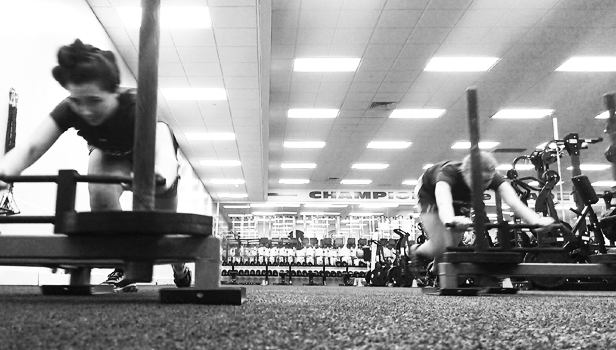
As a strength and conditioning coach working primarily with Olympic sports over the past 15 years, it has recently become my observation that student-athlete motivation is the key to enhancing athletic ability. Any reasonably sound training program, performed with great effort, will produce results. If the key to athletic development was programming, all strength coaches would have the magical book laying out the sure fire plan on our desk, open it to today’s date, and put the student-athlete through that workout. Unfortunately, there is no such book. We hear from coaches all over the country extolling the virtues of their unique programs. It may be linear periodization or undulating, Olympic based or powerlifting influenced, HIT training or training focused on dumbbells, kettle bells or bodyweight exercises. The differences are many. However, I believe the one thing tying them together is getting the student-athlete to put their maximum effort in whatever the program may be. This is the challenge.
For some groups of student-athletes this is easy. For others, it is much more difficult. Football players, by and large, love the weight room. Motivating them is not the greatest challenge. Crank up the music, threaten to tell their coach if they are slacking, challenge their manhood a little bit, and get out of the way. The story on the Olympic side is much different. With the possible exception of your baseball team and track and field throwers, the vast majority of our student-athletes would rather be anywhere else than the weight room. Turning up Justin Timberlake to 11 can only help so much. Blast Metallica and they will complain. Threatening to tell their sport coach they are slacking will probably lead the sport coach to tell you to change your approach. Question their manhood or womanhood and you will be meeting with an Athletic Director that afternoon. How then can we motivate the unmotivated? In layman’s terms, how can we get 20 fencers excited about being in the weight room?
I often say my job as a Strength and Conditioning Coach is not to drag the horse to water and make it drink. I am not a personal trainer. I am not here to take an individual student-athlete by the hand and babysit them through their workout. My job is to make the horse thirsty. Make the horse want to drink the water. Make the student-athlete want to be in the weight room. The best way I have come across doing this is through our Iron Owl program at Temple University.
Iron Owl
The Iron Owl program is a simple point system designed to identify standards of excellence in athleticism, encourage student-athletes to push themselves to higher achievement, and give recognition to those who are training at a higher level. My staff and I identified a variety of exercises we thought lead directly to increased performance. We then assigned varying levels of ability in those exercises, and assigned a point value for each. Receiving one point in a challenge is relatively easy, and something I think every average, NCAA Division I student-athlete should be able to achieve with modest training. Basically it’s a grade of a C. Not good, not bad. Earning three points for a challenge requires a bit more. Essentially it is a B grade. Good. Not outstanding, but pretty competent. Receiving five points is the highest amount. This requires exceptional ability.
Each student-athlete has an Iron Owl score sheet attached to their workout card. They then keep track of their points earned throughout the school year. Unlike conventional end-of-season or end-of-year testing, student-athletes are able to attempt a challenge and track their progress continually throughout the year. We are a bit more cautious with them during their in-season periods. Most of the exercises are ones they will already complete during a training week.
The student-athletes accumulate points and upon reaching 30, 40, or 50 total points are awarded Silver, Gold, or Iron Owl status. When achieving one of these thresholds, a coach will blow a whistle, yell out the status they achieved, and all in the weight room will applaud that athlete. We then have the student-athlete write their name on a large dry-erase board, along with their sport and total points, and take their picture to post on our Facebook page and Twitter accounts (Facebook.com/OwlsStrength, Twitter @IronOwlsTU).
Challenges are varied between those requiring absolute strength, relative strength, muscular endurance and power. Some challenges simply come down to determination and effort. Challenges were varied as a way to assure all athletes across our 21 sports had an equal chance to earn Iron Owl status. An athlete with great absolute strength has no more of an advantage over an athlete with great relative strength in earning their status.
Effectiveness
The Iron Owl program has been a rousing success here at Temple University. It has been fully embraced and promoted by student-athletes and coaches alike. I honestly cannot believe how it has taken off and really defined our Olympic strength and conditioning department. It has undoubtable helped to cultivate the training culture my staff and I had hoped to establish. It is now a common event to have our student-athletes remain long after a workout, or come in on a day off, to accumulate Owl points. I knew we had something when I would talk to administrators and they would ask me, “What is this Iron Owl thing?”
It obviously challenges those highly driven student-athletes to prove themselves amongst their peers and rise to the top of the board. It motivates others to reach higher by seeing their peers up on the board and not themselves. Put one soccer player up on the board and the next day every baseball guy will be busting their tail to make sure they are up their too. The recognition, praise, and affirmation of hard work given the athlete by the whistle blow, name on board and social media presence motivates others. Various sport programs have become competitive and motivated by trying to have more of their student-athletes on the board than the other teams in the department.
Each year the student-athlete has to start over and accumulate points again. We have yet to get a fencer on the board, but they have definitely become thirsty for it.
Testing Standards
Bonus Challenges
Gold Owl: 40+ Points
Silver Owl: 30+ Points
Photos courtesy of Temple University Strength & Conditioning Facebook at https://www.facebook.com/OwlsStrength/photos_stream
Scott Charland currently serves as the Sports Performance Team Leader at Indiana University Health, Indiana’s most comprehensive healthcare system, where he oversees the training of athletes of all ages and ability levels. Prior to IU Health, he was the Head Strength and Conditioning Coach for Olympic Sports at Temple University. Before coming to Temple University, he served as the Director of Strength and Conditioning at Saint Louis University. Scott is also a competitive powerlifter with an elite total in the 198 pound weight class.









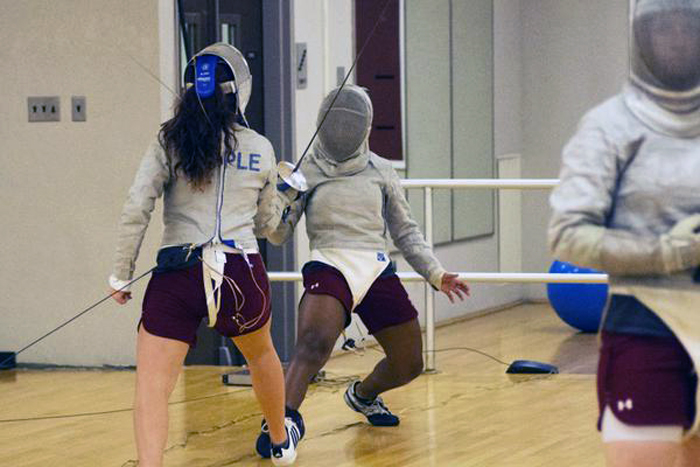
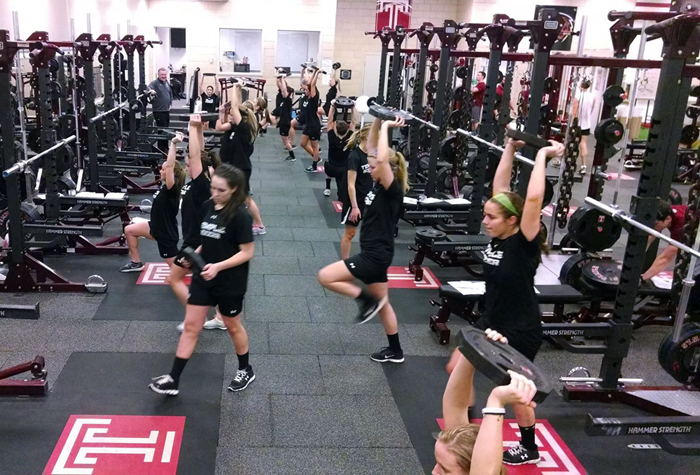
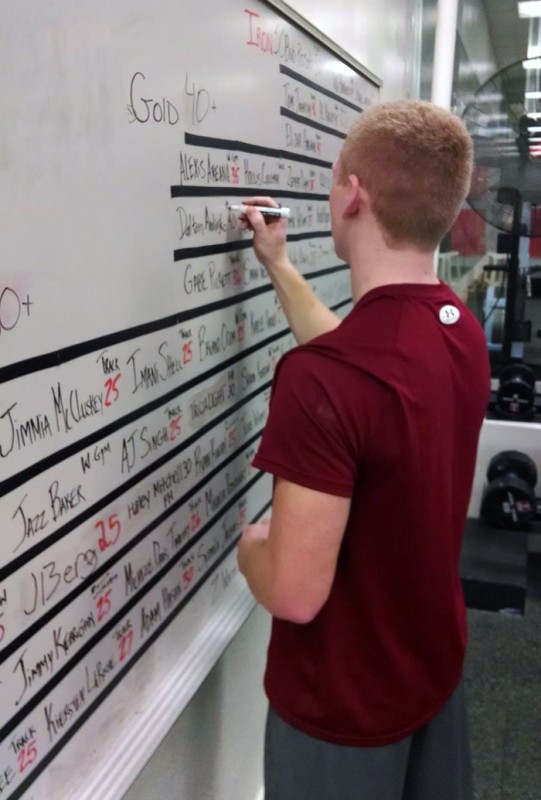


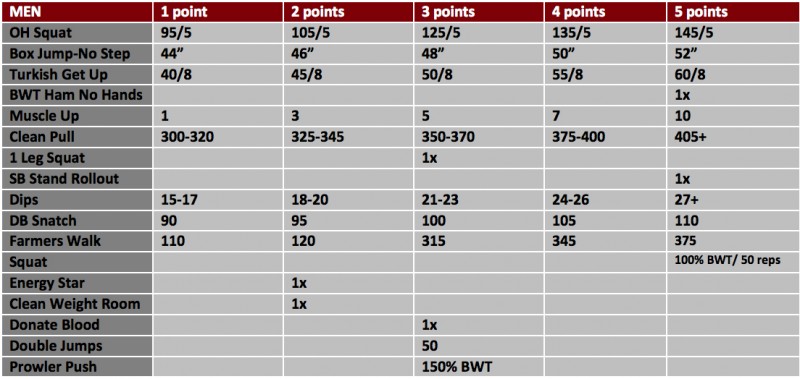
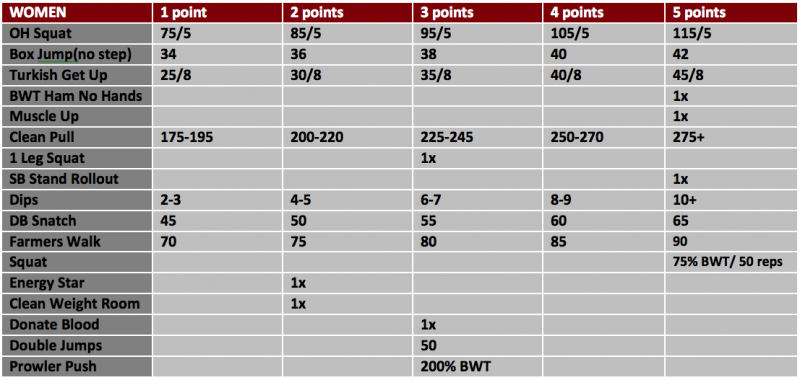
I am going to adopt this to what I have already done. Thank you very much!
Question is we add what each column total to get your score, or as the season moves forward do you add up all your increases...
Likewise, if an athlete can squat 335 every day- he just gets 5 total points, not 5 points each day he does it.
This is just what we came up with- it can be flexible to how you think it would work best in your situation. I would love to hear different ideas on how people use it.
thanks
***An Athlete may earn up to 5 points per exercise
IRON FALCON STRENGTH & SPEED SPRING CHALLENGE
Football 1 point 2 points 3 points 4 points 5 points BW
STRENGTH 215
1 Squat 215 270 325 380 430
2 Deadlift 215 270 325 380 430
3 Bench 165 205 250 280 325
4 Pullups 5+ 10+ 15+ 20+ 25+
5 Dips 10+ 15+ 20+ 25+ 30+
POWER
6 Clean 155 190 230 270 305
7 DB SA Snatch 40 50 60 70 80
8 Box Jump (no step) 39 42 45 48 51
9 Broad Jump 7'5"+ 8'+ 8'5"+ 9"+ 9'5"+
10 Keiser Push Pull 1500+ 1875+ 2250+ 2625+ 3000+
SPEED
11 20 yard Pro Agility 4.4 4.3 4.2 4.1 4
12 40 yard Sprint 5.3 5.1 4.9 4.7 4.5
13 100 yard shuttle <24 <22 <20 <18 <16
14 200 yard shuttle <46 <44 <42 <40 <38
15 300 yard shuttle <68 <66 <64 <62 <60
CHARACTER (BONUS)
16 Clean up the Weight Room 1x
17 Arrived 10 minutes early each day 1x
18 Made every workout all term 1x
***An Athlete has attained IRON FALCON status after earning 80% of the possible points (60 of 75)
***An Athlete has attained Junior IRON FALCON status after earning 70% of the possible points (52.5 of 75)
I came up with the standards after testing DI athletes for 15 years. After a while, you see what's good, what's ok, and what's bad. It's not specific to Temple. I had same standards at Saint Louis University, and would have had same ones had I done it when I worked at Ohio State. Now this is obviously Olympic Sport Athletes- not football. I'm not sure what High School numbers would look like- you'd know better than me.
One thing I looked at was the best testing numbers I had ever gotten- That is the 5 point- and just decrease things from there.
Your set up looks good- as long as you have time and space for the running tests. We wanted to do that- but were really stuck in the weight room and couldn't always time an athlete when they wanted.
I hope it goes well- Let me know!